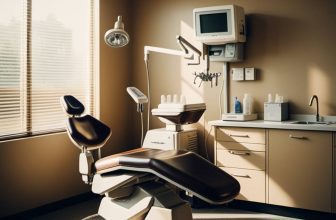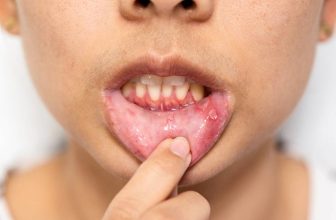If you’ve been told by your dentist or gum doctor that you need a gum graft, don’t panic. Gum surgery is not as bad as it sounds. A gum graft may be necessary to protect your teeth from the damaging effects of gum recession, or you may choose to have one to improve the appearance of your smile.
Gum recession is when the tissue surrounding the teeth pulls away from a tooth, exposing more of the tooth or the tooth’s root. This can cause damage to supporting bone. Gum recession is a common dental problem; it affects 4% to 12% of adults and often goes unnoticed until it becomes more severe.
Many people don’t even notice that their gums have receded because it is gradual. However, an exposed tooth root can look ugly over time and cause tooth sensitivity, especially when eating cold or hot foods. Eventually, gum recession, if not treated, can cause tooth loss. A gum tissue graft may be needed to repair the damage and prevent further dental problems.
What Happens in a Gum Graft Procedure from a Periodontist
A gum graft is a surgical procedure used to improve the appearance and health of the gums. The graft comprises tissue from another part of the mouth or a donor. During the process, the surgeon will remove a thin piece of tissue from the donor site and transplant it to the area where the gums are receding. The transplanted tissue will help fill the gap and protect the teeth from further damage. Gum grafts are typically performed on people with severe gum recession or at risk for developing periodontal disease.
Gum graft surgery is a relatively simple procedure that can be performed in a dentist’s office. The patient will be given a local anesthetic to numb the area, and then the surgeon will remove a small piece of tissue from the donor site. This tissue will be used to form the new graft. The donor site will be closed, and the patient will be sent home with instructions for caring for the wound.
The new graft will take time to heal and grow into place. In most cases, it will take several weeks for the wound to heal completely. During this time, keeping the area clean and debris-free is important. The patient should also avoid smoking and drinking alcohol, which can slow healing. Once the graft has healed, the patient can enjoy improved gum health and a more aesthetically pleasing smile.
Best tips after gum graft surgery for faster recovery

Gum graft surgery is a standard procedure used to treat gum recession. If you are preparing for gum graft surgery or are in the early stages of recovery, here are some tips to help make the process smoother.
1. Listed to your surgeon
Follow your surgeon’s instructions closely. Make sure to take all medication prescribed and attend all follow-up appointments.
2. Be gentle when doing oral hygiene
Be gentle with your gums. Avoid brushing too hard, and use a soft-bristled toothbrush.
3. Rinse your mouth frequently
Rinse with warm salt water regularly. This can help reduce inflammation and promote healing.
4. Eat softly
Avoid biting or chewing on hard objects. This can put stress on your gums and slow the healing process.
5. Stay hydrated
Drink plenty of fluids and eat a healthy diet. This will help keep your body healthy and promote healing.
6. avoid strenuous exercise
Avoid strenuous exercise for the first few weeks after surgery. This can increase blood flow to the area and delay healing.
7. Be patient
Recovery from gum graft surgery can take several weeks. Be patient and follow your surgeon’s instructions. With time and care, you will heal and have a healthy, beautiful smile.
8. avoid tobacco and alcohol
Tobacco and alcohol use can delay healing and increase the risk of complications. If you smoke, it is best to quit before surgery. If you cannot stop, try to avoid smoking for at least a week before and after surgery. Avoiding alcohol for at least 24 hours before and after surgery is also recommended.
9. Manage your pain
You will likely experience some pain and swelling after surgery. Take over-the-counter pain medication as needed and apply ice packs to the outside of your mouth.
Following these tips can help ensure a successful recovery from gum graft surgery. If you have any questions or concerns, talk to your surgeon.
How long does it take to recover from a gum graft?

Most patients take approximately one week to recover from a gum graft. During this time, keeping the area clean and free of debris is important. The patient should also avoid smoking and drinking alcohol, which can slow healing. Once the graft has healed, the patient can enjoy improved gum health and a more aesthetically pleasing smile.
Gum graft healing stages:
1. Immediate Recovery
This is the period right after your surgery. For the first few days, your mouth will feel sore, and you may have some swelling and bleeding. It is important to take it easy and follow your dentist’s instructions during this time.
2. Early Recovery
In the early stages of recovery, the graft site will begin to heal, and the pain will start to subside. You may still have some swelling and tenderness in the area, but this should improve with time.
3. Late Recovery
After a few weeks, the gum tissue will fully heal, and you should no longer experience discomfort. The final stage of recovery is when the new tissue has fully grown in and blended with the existing gum tissue.
How much does a gum graft surgery cost?
The cost of a gum graft varies depending on the extent of the surgery and the dentist performing the procedure. In most cases, insurance will cover at least a portion of the cost. Patients should check with their insurance provider to determine their coverage.
Will I need another surgery in the future?
Do you worry that you might need another gum tissue graft? Don’t worry – while there’s no guarantee that gum problems won’t develop again in the future, regular dental checkups and careful dental care at home can prevent serious damage requiring surgery.
Other ways to prevent gum disease include:
You are brushing your teeth twice a day with fluoride toothpaste, flossing daily, rinsing once or twice a day with an antiseptic mouthwash, eating a well-balanced and healthy diet, and not smoking. So take care of your teeth and gums by following these simple tips, and don’t forget to visit your dentist for routine checkups!
What is the success rate of gum graft surgery?
The success rate of gum graft surgery is very high. In most cases, the transplanted tissue will take hold and begin to grow in the new location.
What are the risks of gum graft surgery?
There are some risks associated with any surgical procedure, including infection, bleeding, and reaction to anesthesia. However, these risks are minimal and can be easily controlled by the dentist.
Frequently Asked Questions
How painful is gum graft surgery?
Most patients report only mild discomfort after the surgery. The pain can be controlled with over-the-counter pain medication or a prescription from the dentist.
How long does gum graft last?
The results of gum graft surgery are usually long-lasting. In most cases, the transplanted tissue will take hold and begin to grow in the new location. Once the graft has healed, the patient can enjoy improved gum health and a more aesthetically pleasing smile.
Is gum grafting worth it?
Yes, gum grafting is often worth it for patients struggling with gum recession or at risk of developing periodontal disease. The surgery can help improve the gums’ appearance and protect the teeth from further damage. Most patients report only mild discomfort after the procedure, and the success rate is very high.







